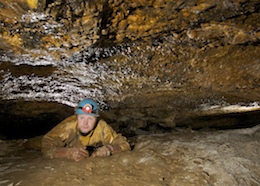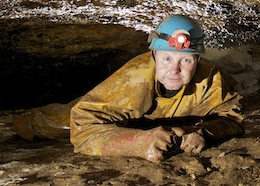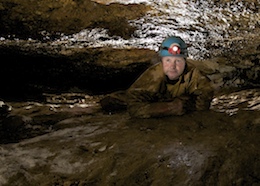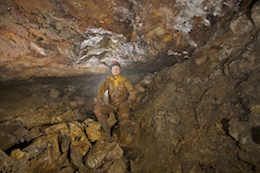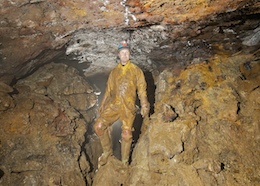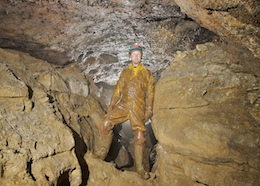Overview
Pwll Y Pasg is very muddy, has lots of loose and sharp rock with very little walking passage, so will remain a collector's piece. Length 355m
Altitude 479m
Grid SO 18233 16082
History
Surveyed by David Ramsay, John Cooper and Clive Gardener in 1984.
Location
Pwll Y Pasg is located on the top of Llangattock above the Swiss Passage area of Agen Allwedd and is best approached from the Beaufort Road. The cave is located in the end of a kidney shaped shakehole, where the grit stones have collapsed to reveal an entry to the cave below. Llangattock Google map showing the location of Pwll Y Pasg and other caves in the area.
Location map - click marker to show entrance photo
Access
No known access restrictions, but should be avoided in the winter months as it is a bat roost.
Description
The cave is formed in the limestone beds just below the gritstone cap rock and through the majority of the cave this gritstone forms the roof of the passages. The cave is located in the end of a kidney shaped shakehole, where the gritstones have collapsed to reveal an entry to the cave below. A scramble down loose boulders leads into the main passage of the cave which quickly reduces in height to a hands and knees crawl as a blind pot is passed on the right. Once past this the crawling becomes flat out and the passage forks left and right. To the left leads to a corner where a dig has enlarged a tight tube that heads towards Ogof Llungwyn, this passage was blocked by a moderate collapse part way through when visited in April 09 but is believed to connect to Ogof Llungwyn. Ogof Llungwyn is a single passage cave and was discovered by digging in the same shakehole as Pwll Y Pasg looking for a continuation of the main Pwll Y Pasg passages at the opposite end of the shakehole. This shakehole entrance is now filled in, presumably after the underground connection was made. Progressing from this tube along the passage you next encounter a debris cone from the collapse of a shakehole above, light can be seen through the boulders in the centre of this passage. Working your way around this run-in of rock and mud, sometimes digging your way through as you go, you can find two side passages that both close down after about 20m. Both offer the rare chance to stand upright in this cave, the first involves traversing over a set of interlinked shafts in the passage floor to reach a choke at the end of the passage. The second is named Lost Passage and trends towards Ogof Llungwyn, terminating in a small low chamber little more than 3m from the nearby Ogof Llungwyn. Back at the main junction on the way in, the right passage first passes the top of Triple Pot, a blind shaft in three sections that narrows towards the bottom. On the left past this a crawl and then a tight squeeze leads into Aragonite Passage that silts up after about 30m. The main passage continues until an area of depressions are found in the floor. In the left of the passage a loose climb down leads to the top of Double Pot. The rock in incredibly sharp and does not lend itself to be rigged with rope. A ladder descent belayed to a scaffold bar will drop you down the first section where a window part way down links into the second half of the pot. At the bottom of this pot a bedding crawl leads from a small chamber into Fools Chamber, containing large boulders and ends in a choke. To the right below Double Pot a 2.5m climb down leads to another short shaft, Griffin Pot named after fluted rock that resembles a Griffin, this leads to a choke and a tight crawl.
Beyond the entrance to Double Pot a flat out dig on the left gives entry to Black Chamber which has no routes off. Soon after this the passage ends at a dig beyond a boulder collapse.
Tackle
Triple Pot 15mDouble Pot 19m
Griffin Pot 6m
References
Cambrian Cave Registry for Pwll Y Pasg Cambrian Cave Registry for Ogof Llungwyn
Caves of South Wales | Tim Stratford | ISBN: 1-871890-03-9 | Published by Cordee
An Exploration Journal of Llangattwg Mountain | Chelsea Spelaeological Society Records V19 - 1992
Warnings
The rock on the pitches is very sharp.
Disclaimer
The photographs and information of this page has been provided to help cavers planning trips. Caving can be a dangerous activity, if you are interested in exploring caves please join a caving club so you can enjoy a safe introduction to this sport. Local caving clubs are listed on the links page or you can visit the 'New To Caving' website for more options.If you feel that any of the information is incorrect or should be updated please contact us.


